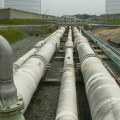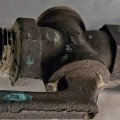Yes, natural gas is delivered to homes through a network of pipes, making it a convenient and efficient fuel source for heating, cooking, and powering appliances. This process involves a series of carefully regulated steps that bring natural gas from underground sources to residential areas, where it can be safely used within households. Natural gas delivery systems, such as those provided by Anytime Plumbing Inc Santa Cruz, California, are designed with a focus on safety and efficiency, relying on a complex infrastructure that includes large transmission pipelines, local distribution networks, and service pipes leading directly to homes. For homeowners, understanding how natural gas enters their house and the role of the piping system can help ensure safe usage and proper maintenance of gas-fueled systems.
The Natural Gas Delivery Process
Natural gas starts its journey in underground reservoirs, where it is extracted and then processed to remove impurities, leaving mostly methane, which is the primary component of natural gas. From there, it travels through high-pressure transmission pipelines that span across large distances, bringing gas to local distribution companies. Once at a local level, the gas pressure is lowered, and the gas is sent through smaller distribution pipelines that reach neighborhoods. Finally, individual service lines connect homes to the main distribution network, allowing natural gas to enter each residence safely. This multi-step process ensures that gas is delivered efficiently and at a manageable pressure for household use.
The Role of House Pipes in Natural Gas Delivery
Within the home, natural gas is channeled through a system of pipes that direct it to specific appliances, such as stoves, heaters, water heaters, and fireplaces. These pipes are typically made of materials designed to withstand gas pressure and prevent leaks, including copper, black steel, or flexible yellow corrugated stainless steel tubing (CSST). The gas piping system inside the home is installed by licensed professionals to ensure it meets all safety codes and regulations. Each appliance is connected to the gas line with a shutoff valve, allowing homeowners to control the gas supply in case of maintenance or an emergency.
Safety Features of Natural Gas Pipes
The infrastructure that delivers natural gas to homes includes numerous safety measures designed to prevent leaks and ensure safe operation. For instance, a chemical called mercaptan is added to natural gas to give it a distinct, sulfur-like odor, making leaks easier to detect. Additionally, gas pipes are equipped with shutoff valves that can stop the flow of gas if a leak is suspected. In the event of an emergency, homeowners are advised to contact professionals like The Plumber Pro, who have the expertise and tools to locate and repair gas leaks safely. Regular inspections and maintenance of gas lines are crucial in ensuring that the system remains leak-free and safe for continued use.
The Importance of Proper Installation and Maintenance
Proper installation and maintenance of gas pipes are essential for preventing gas leaks and ensuring a safe living environment. Natural gas is highly combustible, so even a small leak can pose a serious risk if not addressed. Professional installation ensures that gas lines are correctly fitted, sealed, and connected, reducing the likelihood of leaks. Regular maintenance, such as inspections and pressure testing, can detect potential issues before they become major hazards. Homeowners should be proactive about scheduling annual inspections of their gas lines, especially if they notice any signs of a potential leak, such as the smell of gas or a hissing sound near gas appliances.
Potential Issues with Natural Gas Pipes
While natural gas is generally safe when delivered through well-maintained pipes, several issues can arise over time. Corrosion, for example, can weaken metal pipes, leading to potential leaks. Flexible gas lines, while convenient, are also more susceptible to damage during renovations or if exposed to physical impact. Another potential issue is shifting or settling soil, which can cause underground pipes to crack or disconnect. To mitigate these risks, it’s essential to work with licensed plumbers or gas specialists for repairs and to avoid DIY fixes that might compromise safety.
Detecting and Responding to Gas Leaks
Detecting a gas leak is critical for safety, and there are several signs that homeowners can watch for. Aside from the characteristic rotten egg smell, gas leaks can sometimes produce a hissing or whistling sound near a pipe or appliance. If there’s a leak outside, homeowners may notice dead or discolored vegetation around the gas line. In case of a suspected gas leak, it’s important to avoid using electronic devices, turning on lights, or creating any spark that could ignite the gas. Evacuating the area and contacting emergency services or a professional plumber is the safest course of action. Companies like My Plumber Pro have the training and equipment to handle gas leaks and repairs safely, ensuring that homes remain protected from potential gas hazards.
Benefits of Natural Gas Piping in Homes
Natural gas offers several advantages as a home energy source, including cost efficiency, reliability, and a lower carbon footprint compared to other fossil fuels. Natural gas appliances are often more efficient than electric models, reducing energy costs for heating and cooking. Additionally, natural gas is a reliable energy source, less susceptible to power outages, which means appliances like stoves and water heaters can continue to function even if the electricity is out. With proper maintenance and a well-installed gas piping system, homeowners can enjoy the convenience and benefits of natural gas while minimizing potential risks.
Conclusion
Natural gas enters homes through a series of interconnected pipes that transport it safely from underground sources to household appliances. This intricate system relies on well-maintained pipelines, professional installation, and regular maintenance to ensure that gas reaches homes efficiently and securely. By understanding how natural gas flows through their home and recognizing the importance of proper pipe care, homeowners can take an active role in maintaining a safe environment. With support from trusted professionals like My Plumber Pro, individuals can keep their natural gas systems in top condition, benefiting from a safe, efficient, and reliable energy source for everyday living.




